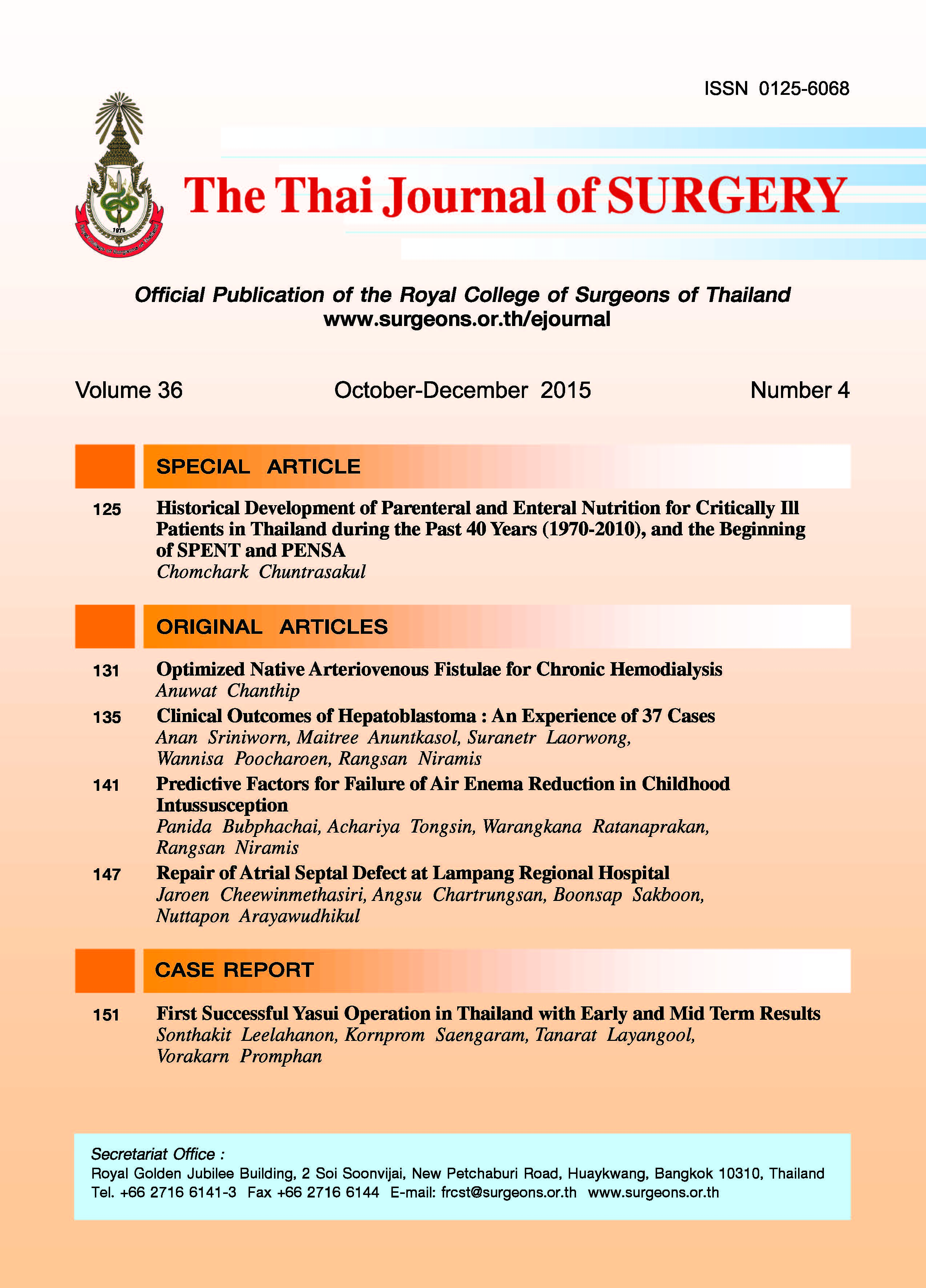Predictive Factors for Failure of Air Enema Reduction in Childhood Intussusception
Keywords:
Intussusception, air enema reduction, predictive factor, success rate, failure rateAbstract
Background: Intussusception is the most common cause of intestinal obstruction in children under two yearsof age. Nonoperative reduction using air enema (AE) is an established treatment of childhood intusseception with
the success rate of 70% at our institute.
Objective: The aim of this study was to evaluate predictive factors for failure of AE reduction in childhood
intussusception.
Materials and Methods: Medical records of patients with intussusceptions who were treated by AE reduction
at Queen Sirikit National Institute of Child Health from January 2009 to December 2013 were reviewed. The study
emphasized on the success and failure rates of AE reduction of intussusceptions including risk factors affecting
outcomes of AE reduction. The statistical differences were analyzed by Chi-square test and relative risk (RR) with
95% confidence interval. A p-value less than 0.05 were considered statistically significant.
Results: Two hundred and sixty-eight patients (173 males and 95 females) with 284 episodes of intussusception
were treated by AE reduction. Of the total 284 attempted AE reduction, 196 (69.0%) were successful, while 88
(31.0%) were unsuccessful. The significant risk factors for failure of AE reduction included body temperature over
37.8 °C (p<0.001, RR = 3.62), lethargy (p=0.001, RR=2.68), rectal bleeding (p=0.003, RR= 2.34), abdominal distension
(p=0.004, RR= 2.23), dehydration (p=0.03, RR=2.30), palpable rectal mass (p<0.001, RR= 19.93), palpable abdominal
mass (p<0.001, RR= 2.72), radiological findings of complete small bowel obstruction (p<0.001, RR= 2.70), visible soft
tissue mass in the left side of abdomen from plain abdominal films (p<0.001, RR=6.92) and intussusception at
sigmoid and rectum (p<0.001, RR=3.25). Complication rates were increased in patients with failed AE reduction
(p<0.001, RR=25.55).
Conclusion: Clinical presentations and radiological findings could be used to predict failure of AE reduction
in childhood intussusception. AE reduction should not be performed in the patients with palpable intussusceptions
in rectum by rectal examination because failure rate was nearly 100% in the present study.
References
current management in infants and children. Surgery
1987;102:704-10.
2. Ravitch MM, Mc Cune RM Jr. Reduction of intussusception
by barium. Ann Surg 1948;128:241-4.
3. Fiorito ES, Recalde Cuestis LA. Diagnosis and treatment of
acute intestinal intussusception with controlled insufflation
of air. Pediatrics 1959;24:241-4.
4. Guo J, Ma X, Zhou Q. Result of air pressure enema reduction
of intussusceptions: 6396 cases in 13 years. J Pediatr Surg
1986;21:1201-3.
5. Eshel G, Barr J, Heiman E, et al. Incidence of intussusception
following barium versus air enema. Acta Pediatr 1997;86:
545-6.
6. Jinzhe Z, Yenxia W, Linchi W, Rectal inflation reduction of
intussusception in infants. J Pediatr Surg 1986;21:30-2.
7. Todani T, Sato Y, Watanabe Y, et al. Air reduction for
intussusception in infancy and childhood. Z Kinderchir 1990;
45:222-6.
8. Niramis R, Watanatittan S, Anuntkosol M, et al. Current
success in the treatment of Intussusception at Queen Sirikit
National Institute of Child Health between 1999 and 2008.
Thai J Pediatr 2010;31:23-30.
9. Niramis R, Havananda S, Suwatanaviroj A, et al.
Intussusception in infancy and childhood : improvement of
clinical outcome in a 33-year period at Queen Sirikit National
Institute of Child Health. Thai J Pediatr 2010;49:117-29 (in
Thai).
10. Beasley SW, Glover J. Intussusception : prediction of outcome
of gas enema. J Pediatr Surg 1992;27:474-5.
11. Fragoco AC, Campos M, Tavares C. Pneumatic reduction
of Childhood intussusception is prediction of failure
important? J Pediatr Surg 2007;42:1504-08.
12. Kritsaneepaiboon S, Sangkhathat S, Kanngurn S. Pneumatic
reduction of intussusception: factors affecting outcome in
Thailand. Asian Biomed 2011;5:235-41.
13. Fike FB, Mortellaro VE, Holcomb GW. Predictors of failed
enema reduction in childhood intussusceptions. J Pediatr
Surg 2012;47:925-7.
14. Gorestein A, Raucher A, Witzling M, et al. Intussusception in
children: reduction with repeated, delayed air enema.
Radiology 1998;206:721-4.
15. Mc Dermott VG, Taylor T, Mackenzie S, et al. Pneumatic
reduction of intussusception : clinical experience and factors
affecting outcome. Clin Radiol 1994;49:30-4.
16. Hollander D den, Burge DM. Exclusion criteria and outcome
in pressure reduction of intussusceptions. Arch Dis Child
1993;68:79-81.
17. Katz M, Phelan E, Carlin JB, et al. Gas enema for the
reduction of intussusception : relationship between clinical
signs and symptoms and outcome. Am J Roentgenol 1993;
160:363-6.
18. Curtis JL, Raucher A, Serour F, et al. Failure of enema
reduction for ileocolic intussusception at a referring hospital
does not preclude repeat attempts at a children’s hospital.
J Pediatr Surg 2010;45:1178-81.
Downloads
Published
How to Cite
Issue
Section
License
Articles must be contributed solely to The Thai Journal of Surgery and when published become the property of the Royal College of Surgeons of Thailand. The Royal College of Surgeons of Thailand reserves copyright on all published materials and such materials may not be reproduced in any form without the written permission.



